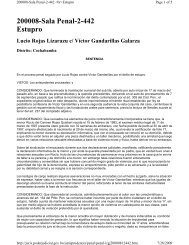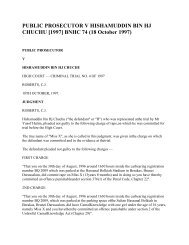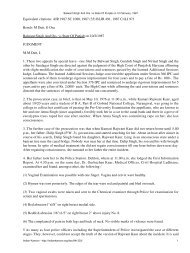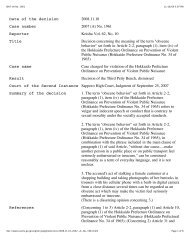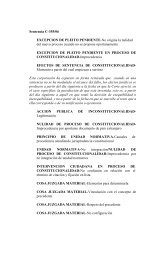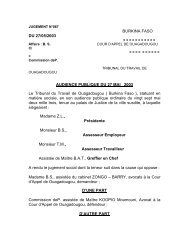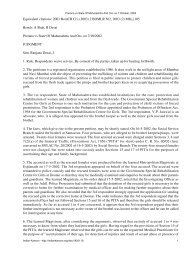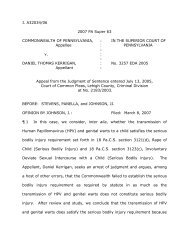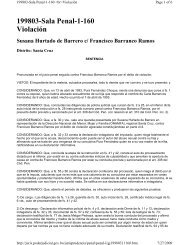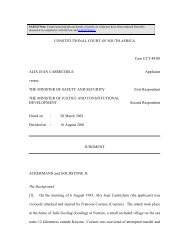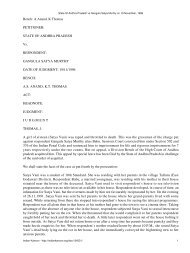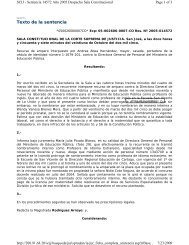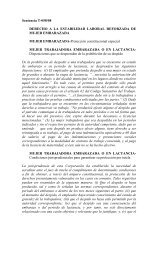P. Rathinam v. Union of India - Cornell University
P. Rathinam v. Union of India - Cornell University
P. Rathinam v. Union of India - Cornell University
- No tags were found...
You also want an ePaper? Increase the reach of your titles
YUMPU automatically turns print PDFs into web optimized ePapers that Google loves.
<strong>of</strong> misery and the accused also belonged to poorer section which added further insult to the injury, would beabuse <strong>of</strong> the process <strong>of</strong> the court. Being <strong>of</strong> this view, each <strong>of</strong> the accused was directed to be acquitted.9. Striking down <strong>of</strong> the section by the Bombay High Court has come to be criticised by the aforesaid ShriPande and Shri Mustafa, so also by Shri D.C. Pande, Research Pr<strong>of</strong>essor, <strong>India</strong>n Law Institute, in his articleon "Criminal Law" [<strong>of</strong> Annual Survey <strong>of</strong> <strong>India</strong>n Law, Vol. 23 (1987) at pp. 260 to 270 <strong>of</strong> published by the<strong>India</strong>n Law Institute]. In the 'Editorial Note' titled 'Taking One's Life' [(1986-87) 91 CWN (Journal Section) atpp. 37 to 40] the Bombay decision received some criticism.10. Before dealing with the points raised in these writings, it would be worthwhile to note that Shri V.S.Deshpande after his retirement as Chief Justice <strong>of</strong> Delhi High Court had expressed his view on this question inhis 1 1987 Cri LJ 743 (1986) 88 Bom LR 589: 1986 Mah LJ 913 (Bom)3 1988 Cri LJ 549 (1987) 2 Andh LJ 263 : 1987 APLJ (Cri) 110 (AP)4 Registered as Cri. Revision No. 230 <strong>of</strong> 1985 403P.<strong>Rathinam</strong> vs <strong>Union</strong> Of <strong>India</strong> on 26 April, 1994article titled "To be or not to be" [(1984) 3 SCC (Journal) at pp. 10 to 15] Shri Deshpande, after referring towhat had been held by this Court regarding the scope <strong>of</strong> Article 21, took the view that if Section 309 isrestricted in its application to attempts to commit suicide which are cowardly and which are unworthy, thenonly this section would be in consonance with Article 21, because, if a person having had no duties to performto himself or to others when he is terminally ill, decides to end his life and relieve himself from the pain <strong>of</strong>living and the others from the burden <strong>of</strong> looking after him, prosecution <strong>of</strong> such a person would be addinginsult to injury and it was asked : "Should a Court construe Section 309 IPC to apply to such cases?"11. Sometime afterwards appeared an article <strong>of</strong> Justice R.A. Jahagirdar <strong>of</strong> Bombay High Court in theIllustrated Weekly <strong>of</strong> <strong>India</strong> (September 29, 1985) in which the learned Judge took the view that Section 309was unconstitutional for four reasons: (1) neither academicians nor jurists are agreed on what constitutessuicide, much less attempted suicide; (2) mens rea, without which no <strong>of</strong>fence can be sustained, is not clearlydiscernible in such acts; (3) temporary insanity is the ultimate reason <strong>of</strong> such acts which is a valid defenceeven in homicides; and (4) individuals driven to suicide require psychiatric care.12. Apart from the aforesaid judicial and legal thinking on the subject relating to justification andpermissibility <strong>of</strong> punishing a man for attempting to commit suicide, there are proponents <strong>of</strong> the view thateuthanasia (mercykilling) should be permitted by law. We do not propose to refer to the thinking on thissubject, principally because the same is beyond the scope <strong>of</strong> the present petitions and also because ineuthanasia a third person is either actively or passively involved about whom it may be said that he aids orabets the killing <strong>of</strong> another person. We propose to make a distinction between an attempt <strong>of</strong> a person to takehis life and action <strong>of</strong> some others to bring to an end the life <strong>of</strong> a third person. Such a distinction can be madeon principle and is conceptually permissible.13. Though what we propose to decide in these cases would, therefore, relate to the <strong>of</strong>fence <strong>of</strong> attemptedsuicide, it is nonetheless required to be stated that euthanasia is not much unrelated to the act <strong>of</strong> committingsuicide inasmuch as wherever passive euthanasia has been held to be permissible under the law, one <strong>of</strong> therequirements insisted upon is consent <strong>of</strong> the patient or <strong>of</strong> his relations in case the patient be not in a position togive voluntary consent. The relationship between suicide and euthanasia has come to be highlighted in adecision <strong>of</strong> the Supreme Court <strong>of</strong> Nevada (one <strong>of</strong> the States <strong>of</strong> United States <strong>of</strong> America) in Mckay v.Bergstedt5 where a patient filed a petition to the court for permitting disconnection <strong>of</strong> his respirator. Thedistrict court, on the facts <strong>of</strong> the case, granted permission. The State appealed to the Supreme Court <strong>of</strong> Nevadawhich, after balancing the interest <strong>of</strong> the patient against the relevant State interest, affirmed the district court'sjudgment. The court took the view that the desire <strong>of</strong> the patient for 404<strong>India</strong>n Kanoon - http://indiankanoon.org/doc/542988/ 3



